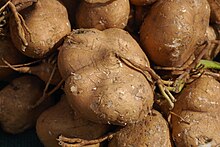Yam bean
| Yam bean | ||||||||||||
|---|---|---|---|---|---|---|---|---|---|---|---|---|

Yam bean ( Pachyrhizus erosus ), illustration |
||||||||||||
| Systematics | ||||||||||||
|
||||||||||||
| Scientific name | ||||||||||||
| Pachyrhizus erosus | ||||||||||||
| ( L. ) Urb. |
The yam bean ( Pachyrhizus erosus ), also Bengkuang called, is a plant from the genus of the yam bean ( Pachyrhizus ) within the sub-family of the Papilionaceae (Faboideae). It has its origins in Mexico , where it is called Jícama ( Nahuatl for "tasty"). Today it is also grown in Africa and Asia for its tubers and seeds . It is a tropical plant with a high demand for heat and water.
description
The yam bean is a perennial herbaceous plant that grows up to 5 m long . On younger plants it forms yellow-brownish and beet-shaped root tubers with a diameter of up to 20–35 cm and up to about 2 kg in weight, on old plants they can be up to 2 meters long and 20 kg in weight, which serve as water storage and persistence organs. However, it is grown as an annual plant , the tubers are harvested and the plant is re-sown in the following year.
The long-stalked leaves are threefold. The broad, rhombic to ovate or broadly triangular to obovate and bristly hairy, mostly pointed leaflets are entire to coarse, distantly toothed or lobed. The leaflet width is partly unequal and there are stipules.
The racemose inflorescences hang or stand upright, are up to 40–60 cm long and contain one to five flowers. The corolla of the short-stalked, hermaphrodite butterfly flowers is white, blue-violet or coral-red, the calyx is brown.
The plant forms flat, finely hairy, slightly constricted and short-pointed legumes that are 8 to 14 cm long and contain five to eleven seeds. The roundish to square, smooth and somewhat flattened seeds have a diameter of 5 to 11 mm and their colors range from beige to red-brown to orange.
The number of chromosomes is 2n = 22, less often 20.
use
The root tuber, which in Mexico is mainly eaten as a snack between meals, is mainly used. In Mexico, street vendors everywhere offer the jícama cut into strips with lime juice , salt and chili sauce and / or chili powder, or with chamoy . The consistency of the Jícama is similar to that of a radish and, just like this, the consistency of the Jícama ranges from woody to juicy. The taste is slightly earthy and sweet. The physiological calorific value is approx. 170 kJ / 100 g (= 40 kcal / 100 g). It contains calcium , phosphorus and vitamin C .
The leaves and pods are not edible. Their poisonous seeds are pulverized and used as an insecticide . The strong fibers of the stem were used to make fishing nets.
literature
- TK Lim: Edible Medicinal and Non-Medicinal Plants. Volume 10: Modified Stems, Roots, Bulbs. Springer, 2016, ISBN 978-94-017-7275-4 , pp. 465-481.
Web links
- Pachyrhizus erosus at Useful Tropical Plants.
- Walter H. Schuster, Joachim Alkämper, Richard Marquard & Adolf Stählin: Legumes for grain use: Grain legumes of the world , Justus Liebig University Gießen, 1998 .: Joachim Alkämper: Information on the tuber bean ( Pachyrrhizus erosus ) .
Individual evidence
- ↑ Pachyrhizus erosus at Tropicos.org. In: IPCN Chromosome Reports . Missouri Botanical Garden, St. Louis

